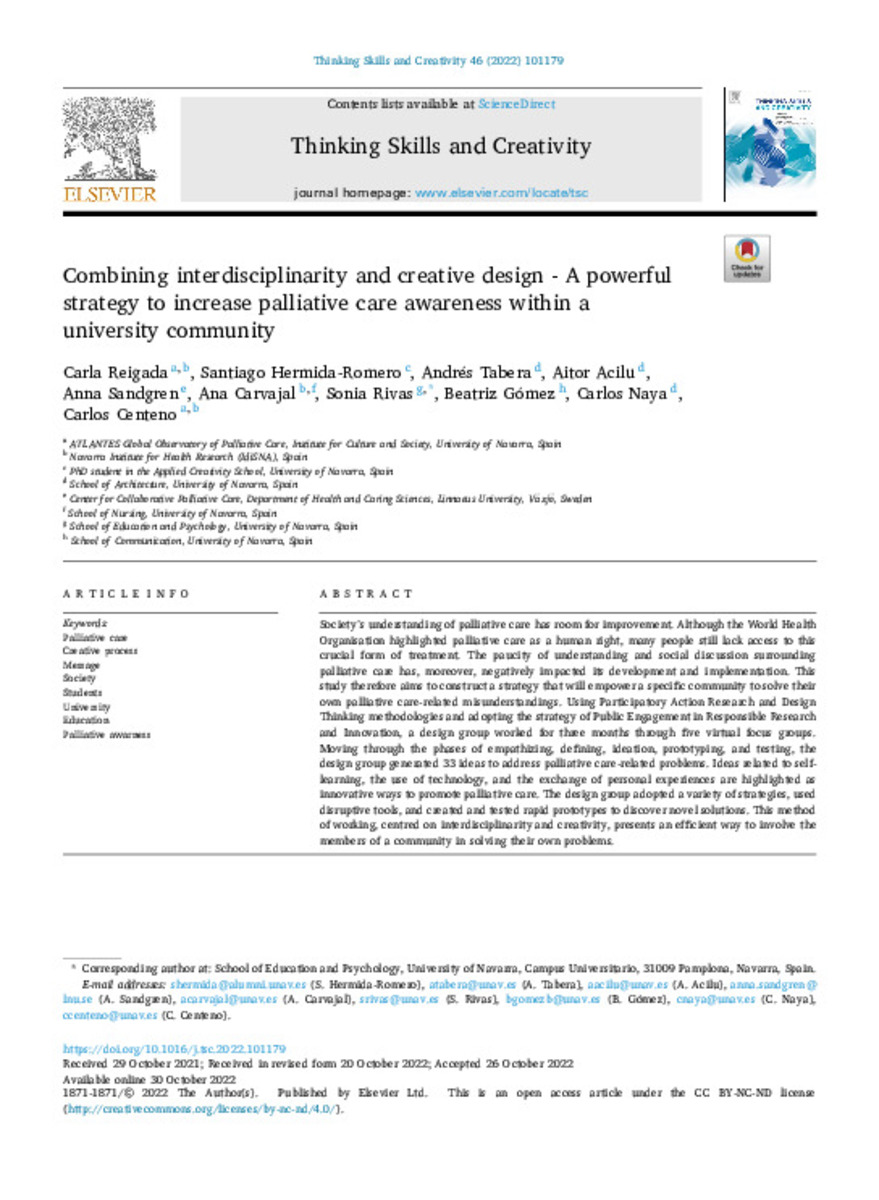Full metadata record
| DC Field | Value | Language |
|---|---|---|
| dc.creator | Reigada, C. (Carla) | - |
| dc.creator | Hermida-Romero, S. (Santiago) | - |
| dc.creator | Tabera-Roldán, A. (Andrés) | - |
| dc.creator | Acilu, A. (Aitor) | - |
| dc.creator | Sandgren, A. (Anna) | - |
| dc.creator | Carvajal, A. (Ana) | - |
| dc.creator | Rivas, S. (Sonia) | - |
| dc.creator | Gómez, B. (Beatriz) | - |
| dc.creator | Naya-Villaverde, C. (Carlos) | - |
| dc.creator | Centeno, C. (Carlos) | - |
| dc.date.accessioned | 2023-05-03T08:11:12Z | - |
| dc.date.available | 2023-05-03T08:11:12Z | - |
| dc.date.issued | 2022 | - |
| dc.identifier.citation | Reigada, C. (Carla); Hermida-Romero, S. (Santiago); Tabera-Roldán, A. (Andrés); et al. "Combining interdisciplinarity and creative design - A powerful strategy to increase palliative care awareness within a university community". Thinking Skills and Creativity. 46, 2022, 101179 | es_ES |
| dc.identifier.issn | 1878-0423 | - |
| dc.identifier.uri | https://hdl.handle.net/10171/66146 | - |
| dc.description.abstract | Society’s understanding of palliative care has room for improvement. Although the World Health Organisation highlighted palliative care as a human right, many people still lack access to this crucial form of treatment. The paucity of understanding and social discussion surrounding palliative care has, moreover, negatively impacted its development and implementation. This study therefore aims to construct a strategy that will empower a specific community to solve their own palliative care-related misunderstandings. Using Participatory Action Research and Design Thinking methodologies and adopting the strategy of Public Engagement in Responsible Research and Innovation, a design group worked for three months through five virtual focus groups. Moving through the phases of empathizing, defining, ideation, prototyping, and testing, the design group generated 33 ideas to address palliative care-related problems. Ideas related to self- learning, the use of technology, and the exchange of personal experiences are highlighted as innovative ways to promote palliative care. The design group adopted a variety of strategies, used disruptive tools, and created and tested rapid prototypes to discover novel solutions. This method of working, centred on interdisciplinarity and creativity, presents an efficient way to involve the members of a community in solving their own problems. | es_ES |
| dc.description.sponsorship | We would like to thank all the students who took part in the study. A sincere thanks to the EnPositive-PAL Research Group for their contribution to this work and the Institute for Culture and Society of the University of Navarra for funding this research. | es_ES |
| dc.language.iso | eng | es_ES |
| dc.publisher | Elsevier | es_ES |
| dc.rights | info:eu-repo/semantics/openAccess | es_ES |
| dc.subject | Palliative care | es_ES |
| dc.subject | Creative process | es_ES |
| dc.subject | Message | es_ES |
| dc.subject | Society | es_ES |
| dc.subject | Students | es_ES |
| dc.subject | University | es_ES |
| dc.subject | Education | es_ES |
| dc.subject | Palliative awarness | es_ES |
| dc.title | Combining interdisciplinarity and creative design - A powerful strategy to increase palliative care awareness within a university community | es_ES |
| dc.type | info:eu-repo/semantics/article | es_ES |
| dc.description.note | This is an open access article under the CC BY-NC-ND license | es_ES |
| dc.identifier.doi | 10.1016/j.tsc.2022.101179 | - |
| dadun.citation.publicationName | Thinking Skills and Creativity | es_ES |
| dadun.citation.startingPage | 101179 | es_ES |
| dadun.citation.volume | 46 | es_ES |
Files in This Item:
Statistics and impact
Items in Dadun are protected by copyright, with all rights reserved, unless otherwise indicated.






